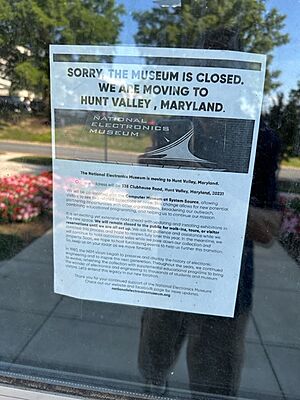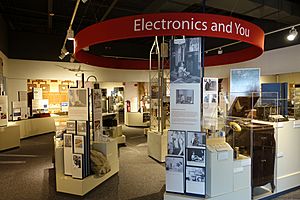National Electronics Museum facts for kids
| Lua error in Module:Location_map at line 420: attempt to index field 'wikibase' (a nil value). | |
| Established | 1980 |
|---|---|
| Location | Hunt Valley, Maryland (Open) Linthicum, Maryland (previous) |
| Founder | Robert Dwight |
The National Electronics Museum in Hunt Valley, Maryland, shows the amazing history of electronics used for defense in the United States. The museum has many cool exhibits. You can see old telegraphs, radios, radars, and even satellites.
The museum is easy to get to, located near the Gilroy Road light rail stop. Many exhibits let you get hands-on with electronics. There's also a library where you can do research. Plus, an amateur radio station, K3NEM/W3GR, broadcasts live from the museum every week! It uses both old and new communication gear.
Contents
How the Museum Started
The National Electronics Museum was created by people who worked at Westinghouse. Robert L. Dwight, who worked at Westinghouse in Baltimore, started collecting items in 1973. He held a "Family Day" to show off his co-workers' projects to their families.
This event was called "Yesterday, Today, and Tomorrow." It showed how Westinghouse had grown over the years. Dwight then wanted to find more radar systems and other electronics for people to see.
Getting the First Radar
His first big goal was to get a special radar from the Department of Defense. This radar was from a BOMARC missile. It was the first radar that could be used in the air to detect moving objects.
To get this radar, they needed to become a non-profit museum. This meant they wouldn't make money from their work. With help from a Westinghouse lawyer, they officially started the National Electronics Museum in 1980.
Growing Over the Years
Westinghouse helped the museum with money and storage space. In 1983, the museum got a space of about 190 square meters (2,000 sq-ft). By 1986, it had grown to 370 square meters (4,000 sq-ft).
At first, only volunteers ran the museum. But in 1989, they hired their first professional employee. The museum then moved to Friendship Square in 1992.
In 1996, a company called Northrop Grumman bought Westinghouse. They continued to support the museum. The museum closed for a short time in 1999 for construction. It reopened with a huge space of over 2,000 square meters (22,000 sq-ft). This new space included a conference room, an event hall, a gallery, and a special warehouse to protect items.
The museum offers fun learning programs. These include YESS (Young Engineers and Scientists) and the yearly Robot Fest. They also offer the Robert L. Dwight scholarship. The museum gets help from donations and grants.
Many people help the museum, including former Westinghouse employees. Over 30 volunteers give more than 5,000 hours of their time each year.
In 2023, the museum moved from its old location in Linthicum. As of 2024, it is open in Hunt Valley, Maryland. It is right next to the Computer Museum at System Source.
What You Can See: Galleries
The National Electronics Museum has twelve different exhibit areas, called galleries:
- Fundamentals Gallery: Learn about the basics of electricity and early electronics.
- Communications Gallery: See how we communicate, from the telegraph to modern computers. This gallery also has Ham Radio and the famous Enigma Machine.
- Early Radar Gallery: Discover radar from World War II. This includes the actual SCR-270 unit used at the Opana Radar Site on December 7, 1941.
- Cold War Radar Gallery: The Cold War led to many new technologies, including advanced radar.
- Modern Radar Gallery: See how radar has continued to improve over time.
- Countermeasures Gallery: Learn about ways to hide from radar, like jammers and special receivers.
- Under Seas Gallery: Explore SONAR and other underwater technologies.
- Electro-optical Gallery: Understand infrared light and how it's used in technology.
- Space Sensor Gallery: See technologies used outside Earth, from satellites to Moon cameras.
- Temporary Gallery: This space changes regularly, showing new and special exhibits.
- Outside Gallery: Six historic radar antennas are displayed outside the museum. They show 75 years of radar development.
Fun Events
- RobotFest: This exciting event is held at the museum every year.
- Pioneer Camp: A summer camp held at the museum each year.
See Also




